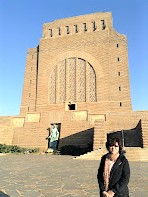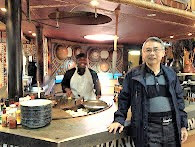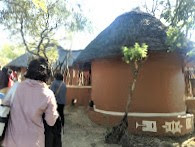Voortrekker Memorial was built to commemorate the migration of the Afrikaners and the Dutch from the Cape colony to Pretoria region between 1835 to 1854. This Memorial is sited strategically on a hill overlooking Pretoria.
The tour guide told us the history based on the numerous panels of carved human figures on the walls. After the Voortrekkers migrated to the area of present day Pretoria, frequent clashes happened between the Voortrekkers and the Zulu people. Finally, the idea of having a ceasefire agreement was mooted. Voortrekkers' leaders were invited under false pretence by the Zulu king, Dinggane for a peace negotiation. Piet Retief, Piet Uys along with 70 men with boys among them and 30 servants entered Zulu's region unarmed. That night, all the Voortrekkers were murdered by the Zulu.
Because of the renege, the Voortrekkers were deeply angered by such dishonourable act and vowed to avenge their dead compatriots.
Andries Pretorius led 470 men and 64 wagons into Dingane's territory on 16 December 1838. They won over an attacking army of 10,000 to 15,000 Zulu warriors. The Zulus sustained losses of an estimated 3,000 warriors in what became known as the "Battle of Blood River". The Boers sustained no casualties.
After the battle, Pretorius made an agreement with Dingane's brother which forced Dingane and those loyal to him into exile.
The Boers believed that God granted them victory and thus promised that their descendants would commemorate the day of the battle as a day of rest. Boers remembered it as "Dingane's Day" until 1910. It was renamed "Day of Vow", later "Day of Covenant", and made a public holiday by the South African government. After the dismantling of apartheid in 1994, the new government kept the day as a public holiday as an act of conciliation to the Boers, but renamed it "Day of Reconciliation".
The name of the city, Pretoria was named after Pretorius.
According to the local tour guide, every year on 16 December, many Boers come to pray non-stop the whole day at this Memorial.
At 12.00 noon on 16 December every year, the sunlight passes through the specially built hole at the roof top and lands exactly onto the memorial stone at the ground floor. This is quite an achievement in engineering and astronomy.
The roof level balcony has a good view of Pretoria.
After the dismantling of apartheid, the black took over power from the white. This Memorial which in a way could be perceived as being shameful to the Zulu is still being retained as a sign of reconciliation. Of course, this Memorial is now a key foreign exchange earner for South Africa. Removal of this iconic structure would be disastrous.
I believe Malaysia, known for distorting certain part of the national history to promote the agenda of a dominant race can learn a lot from this Memorial.

























































